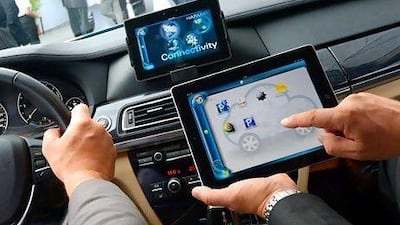In the not-too-distant future, your alarm clock will rouse you out of bed earlier than normal if it knows you need to avoid a traffic jam on the way to work.
Once inside your car, it will tell the house to turn off the heating, go into electricity saving mode and even enable the alarm system.
This high level of interconnected devices and home appliances was in focus last week at the IFA Berlin conference in Germany, one of the biggest consumer electronic showcases in the world with 1,400 exhibitors from 50 countries.
The big names in attendance included Sony, Samsung, Philips, Sharp and Panasonic.
Only Apple was missing, but it was expected to make waves on its own with an announcement next week about the iPhone 5.
Pim Van Der Jagt, the managing director of Ford Motor's research centre in Aachen, Germany, is tasked with putting technology into cars, and he believes a lifestyle like the one described above is only a few years away.
"We are going a bit further," he says. "We are seeing part of the car journey where the vehicle just takes over."
Ford has a voice-activated system in its cars called Ford Sync, which was developed in conjunction with Microsoft.
The system already has an application called Allergy Alert that uses your smartphone and tells you when you are driving through hot spots for allergies and what different routes to take.
Cars connected to smartphones, smartphones connected to TVs, TVs connected to tablets, tablets connected to washing machines. It was all the rage at IFA.
And no other company embraced this integrated approach more than Sony, which was first to showcase its wares.
The Japanese electronics giant unveiled a host of new products at the conference as the once-darling of global electronics now drastically tries to revitalise its business.
In the last quarter, Sony fell off the top 10 list of best-selling mobile phones in the world, according to Gartner, the technology research firm.
Its television division has been loss-making for eight years, and last monthSony said it had lost ¥24.6 billion (Dh1.15bn) in its fiscal first quarter, which runs from April to June, compared with a ¥15.5bn loss a year earlier. In April, the company said it would cut 10,000 jobs.
So IFA Berlin was crucial for Sony, perhaps more than any other brand.
Sony's new strategy of trying to integrate all of its products, including smartphones, laptops, TVs and its entertainment division's assets, comes when the industry is at a crossroads as it moves towards this brave new world.
"Mobile devices are the gateway to Sony's user experience," said Kazuo Hirai, Sony's chief executive, last week at IFA.
"This company drives innovation rather than reacting to it … Technology and entertainment assets are materially beneficial as growth engines for Sony."
The brand's mobile division is still in its relative infancy after Sony announced earlier this year that it had completed its purchase of Ericsson's stake in Sony Ericsson, a joint venture now known as Sony Mobile Communications.
The division unveiled three new smartphones and a tablet, all under the Xperia brand at IFA.
The company's huge stand displayed how the new phones were fitted with near-field-communication (NFC) technology.
This allowed easy access to Sony's digital library of movies and TV shows, games from its PlayStation brand, as well as links to the company's digital cameras and televisions.
"Sony has been known as an innovator traditionally in cameras, televisions, gaming and notebook computers. They've certainly been that," says Ashish Panjabi, the chief operating officer of Jacky's Electronics in the UAE.
"In smartphones and tablets though, they quite haven't been able to make their mark. However, this isn't to say things can't change for Sony... If Sony Mobile is now 100 per cent owned by Sony, the hope is that this [research and design] know-how can move on to Sony's smartphone and tablet products as well."
Samsung and Panasonic were the other big proponents at IFA of greater connectivity between products.
Using NFC technology, smartphones can now be used to turn on the washing machine and tell it what stains need to be washed out.
Photos can be swished from a Panasonic smartphone straight on to a TV with the flick of a finger.
And a Panasonic oven can now be preset using a smartphone.
Samsung has designed a TV on which two people can watch different programmes at the same time, using special glasses.
"I definitely see this coming in the future. We are already connected almost anywhere - today you can bring your TV with you and you can bring your internet on the TV with all the new Smart TVs including Samsung's latest models," says Julien Pascual, the chief executive of EmiratesAvenue, a UAE online retailer.
"Brand loyalty is fully influenced by the multiplication of multimedia devices you get. If you look at Apple's history and sales, once they finally got the hit product they were waiting for, the iPod, millions of people discovered Apple in a new way and went ahead to buy MacBook laptops - same way today with the iPhone and iPad."
This is the crux of the industry move to integration between devices, as well as the key to Sony returning to profit.
If manufacturers can convince customers that they need to buy all their devices from one brand to get the most out of all the devices, then greater cross-selling will benefit revenues and profits.
"The main story we want to tell is not only that we have three new Xperia devices, but with the Xperia tablet, we have a family of devices that consumers expect under a one brand umbrella," says Nikolaus Scheurer, the director of marketing planning at Sony Mobile.
"People stay on the same ecosystem. If someone has an Android smartphone, they want an Android tablet."

